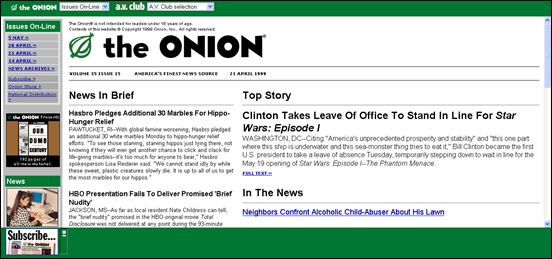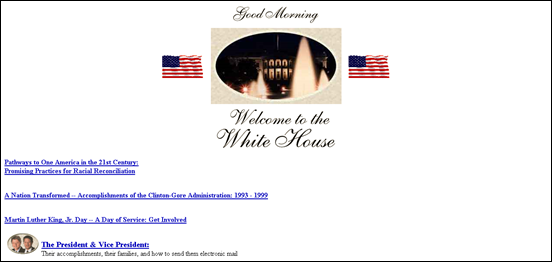 Amazon.com had a liquid layout and looked very similar to how it is today.
Amazon.com had a liquid layout and looked very similar to how it is today.
 BBC
was reporting on the murder of Jill Dando.
BBC
was reporting on the murder of Jill Dando.
 Microsoft.com offered a download of Internet Explorer 5.
Microsoft.com offered a download of Internet Explorer 5.
 Wired Magazine
Wired Magazine
 Yahoo! was currently showing a sneak peak of their new homepage, but it used to look like this for quite a while.
Yahoo! was currently showing a sneak peak of their new homepage, but it used to look like this for quite a while.
 Monster.com: Many a CV has passed through here since 1999.
Monster.com: Many a CV has passed through here since 1999.
 The Onion.com
, built with frames, remember them?
The Onion.com
, built with frames, remember them?
 The White House is the most dramatically changed of all the ten web sites listed here.
The White House is the most dramatically changed of all the ten web sites listed here.
 Oh look! A new search engine.
Oh look! A new search engine.
 What were YOU doing in 1999? And what do you think about how some of these web site designs have (or haven’t) changed in ten years.
What were YOU doing in 1999? And what do you think about how some of these web site designs have (or haven’t) changed in ten years.
Frequently Asked Questions (FAQs) about Websites Ten Years Ago
How have websites evolved over the past decade?
Over the past decade, websites have undergone significant changes in terms of design, functionality, and user experience. Ten years ago, websites were primarily text-based with minimal graphics and limited interactivity. Today, websites are more visually appealing, with high-quality images, videos, and interactive elements. They are also more user-friendly, with intuitive navigation and responsive design that adapts to different devices. Moreover, websites today are more focused on providing value to users, with high-quality content and personalized experiences.
What were some popular websites ten years ago?
Ten years ago, some of the most popular websites included Google, Yahoo, and MSN. Social media platforms like Facebook and Twitter were also gaining popularity. Other popular websites included Amazon, eBay, and Wikipedia. These websites were popular due to their unique offerings and user-friendly interfaces.
How has the role of websites in our lives changed over the past decade?
The role of websites in our lives has significantly evolved over the past decade. Ten years ago, websites were primarily used for information retrieval and online shopping. Today, websites serve a multitude of purposes, from social networking and entertainment to online learning and remote work. They have become an integral part of our daily lives, influencing how we communicate, learn, work, and entertain ourselves.
How has the technology behind websites evolved over the past decade?
The technology behind websites has significantly evolved over the past decade. Ten years ago, websites were primarily built using HTML and CSS. Today, websites are built using a variety of technologies, including JavaScript, Python, and Ruby on Rails. Additionally, the rise of content management systems like WordPress and Drupal has made it easier for non-technical individuals to create and manage websites.
What were some of the design trends for websites ten years ago?
Ten years ago, website design trends included simple layouts, minimal graphics, and a focus on text-based content. Other trends included the use of tables for layout, static HTML pages, and limited use of multimedia elements. Today, website design trends include responsive design, parallax scrolling, and the use of high-quality images and videos.
How has the user experience on websites changed over the past decade?
The user experience on websites has significantly improved over the past decade. Ten years ago, websites were often difficult to navigate and not optimized for mobile devices. Today, websites are designed with the user in mind, with intuitive navigation, responsive design, and personalized experiences.
What were some of the challenges faced by website developers ten years ago?
Ten years ago, website developers faced several challenges, including limited technology, lack of standards, and difficulties in ensuring cross-browser compatibility. Additionally, optimizing websites for search engines was a complex task due to the lack of clear guidelines and tools.
How has the importance of websites for businesses changed over the past decade?
The importance of websites for businesses has significantly increased over the past decade. Ten years ago, having a website was considered a luxury for many businesses. Today, a website is a necessity for any business, regardless of its size or industry. Websites serve as a platform for businesses to showcase their products or services, engage with customers, and drive sales.
How has the process of creating websites changed over the past decade?
The process of creating websites has become more streamlined and efficient over the past decade. Ten years ago, creating a website required extensive knowledge of HTML and CSS. Today, there are numerous tools and platforms available that make the process of creating a website easier, even for individuals with no coding experience.
What can we expect from websites in the next decade?
In the next decade, we can expect websites to become even more interactive, personalized, and user-friendly. Advances in technology, such as artificial intelligence and virtual reality, will likely play a significant role in shaping the future of websites. Additionally, the importance of websites for businesses and individuals will continue to grow, as they become an even more integral part of our daily lives.
Jennifer Farley is a designer, illustrator and design instructor based in Ireland. She writes about design and illustration on her blog at Laughing Lion Design.


